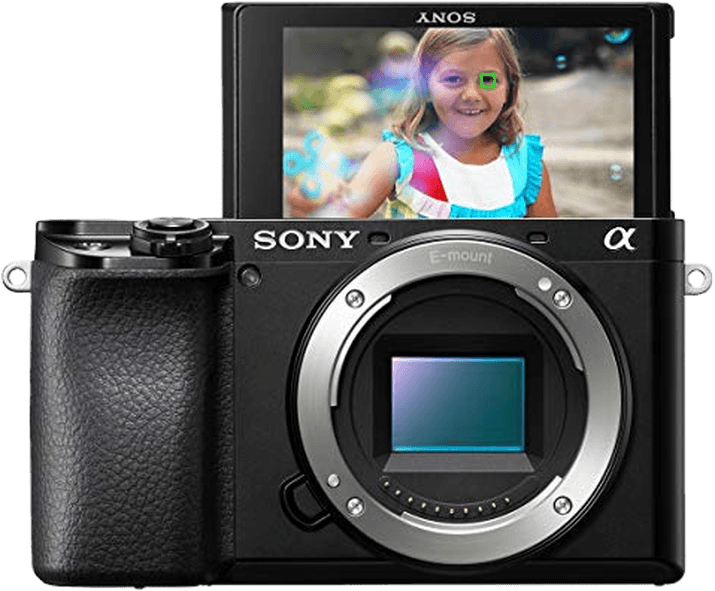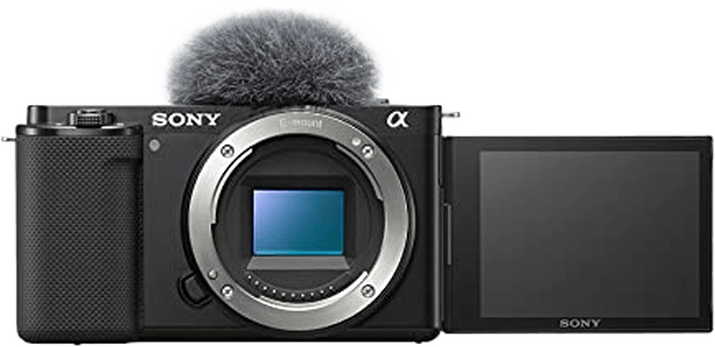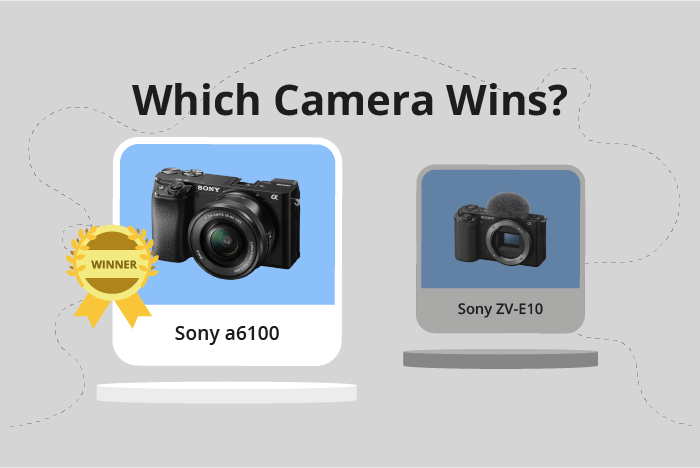Sony a6100 vs ZV-E10 Comparison
Sony a6100

Sony ZV-E10

The Sony a6100 edges out the Sony ZV-E10 with a score of 66/100 versus 65/100. Both cameras are mirrorless and were released two years apart, with the a6100 in 2019 and the ZV-E10 in 2021. They share similarities in launch price, with the a6100 at $750 and the ZV-E10 at $700.
The a6100 has a slight advantage in size and weight, measuring 120 x 67 x 59mm and weighing 396g, compared to the ZV-E10’s 115 x 64 x 45mm and 343g. This difference makes the a6100 a bit more robust and stable for various shooting situations.
On the other hand, the ZV-E10’s more recent release date and lower launch price make it an attractive option for those looking to save a bit of money while still getting a quality mirrorless camera.
Taking all factors into consideration, the Sony a6100 comes out ahead, but the ZV-E10 remains a viable option for budget-conscious photographers.
Sony a6100 vs ZV-E10 Overview and Optics
The Sony ZV-E10 narrowly outperforms the Sony a6100 in terms of optics, with a score of 69/100 compared to the a6100’s 68/100. Both cameras share several specifications, including 24-megapixel resolution, 11fps shooting speed, CMOS sensor type, Bionz X processor, APS-C sensor size, Sony E lens mount, and lack of image stabilization.
The ZV-E10’s higher score can be credited to its superior DXOMARK sensor score of 86, compared to the a6100’s 82, and its 4:3 aspect ratio. These features provide the ZV-E10 with improved image quality and versatility in various shooting conditions. Additionally, the 4:3 aspect ratio offers more flexibility for cropping and framing photos, making it a better option for photographers who want to make the most of their images.
On the other hand, the Sony a6100 has a 3:2 aspect ratio, which, while not as versatile as the ZV-E10’s 4:3 ratio, is still a popular choice for photographers and provides high-quality images. The a6100’s slightly lower DXOMARK sensor score does not significantly affect its overall performance, and it remains a reliable camera for capturing sharp, detailed images.
Taking these factors into account, the Sony ZV-E10 has a slight edge over the Sony a6100 in terms of optics due to its higher DXOMARK sensor score and more versatile aspect ratio. However, the a6100 remains a solid option for photographers who prefer the 3:2 aspect ratio and are not significantly influenced by a small difference in sensor scores. Both cameras offer excellent performance and share many essential specifications, making them suitable choices for various photography needs.
Sony a6100 vs ZV-E10 Video Performance
The Sony a6100 and Sony ZV-E10 tie in video capabilities with a score of 91/100. Both cameras share several video specifications, including 4K maximum video resolution, 120fps maximum video frame rate, and built-in time-lapse functionality. However, there are differences in their video dimensions and unique features that cater to specific user needs.
The Sony a6100 has an advantage with its maximum video dimensions of 3840 x 2160, offering slightly higher resolution than the Sony ZV-E10’s 3840 x 1920. This difference in resolution results in a more detailed and sharper video output, making the a6100 a better choice for users who prioritize video quality.
On the other hand, the Sony ZV-E10 caters more to content creators and vloggers with its user-friendly features and compact design. While its video dimensions are slightly lower than the a6100, the difference is not significant enough to impact the overall video quality. The ZV-E10 still delivers excellent 4K video performance and may be more suitable for users who value ease of use and portability.
Both the Sony a6100 and ZV-E10 excel in video performance, with the a6100 providing a marginal advantage in video dimensions. Users should carefully consider their specific needs and preferences when choosing between these two cameras. While the a6100 may be a better choice for those seeking the highest video resolution possible, the ZV-E10 offers a more user-friendly experience for content creators and vloggers without sacrificing much in terms of video quality.
Sony a6100 vs ZV-E10 Features and Benefits
The Sony a6100 and Sony ZV-E10 have identical feature scores of 68/100. Both cameras share several specifications, including a 3-inch screen size, touchscreen capabilities, flip screen, and lack of GPS. Additionally, both cameras are equipped with WIFI and Bluetooth connectivity.
The Sony a6100 is superior to the Sony ZV-E10 in terms of screen resolution, boasting 921,600 dots compared to the ZV-E10’s 920,000 dots. This difference provides slightly sharper and clearer image previews on the a6100’s screen, enhancing the user experience in image composition and review.
On the other hand, the Sony ZV-E10 does not have any specific feature that makes it better than the a6100. Both cameras have the same feature score and share most of their specifications, making them very similar in terms of functionality.
To conclude, the Sony a6100 and Sony ZV-E10 are highly comparable cameras with identical feature scores. The only notable advantage of the a6100 is its marginally higher screen resolution. However, this difference is minimal and might not significantly impact the user experience. As such, potential buyers should consider other factors, such as price and personal preferences, when choosing between these two cameras.
Sony a6100 vs ZV-E10 Storage and Battery
The Sony a6100 outperforms the Sony ZV-E10 in storage and battery with a score of 37/100 compared to the ZV-E10’s 24/100. Both cameras have one memory card slot and accept SD/SDHC/SDXC and Memory Stick Pro Duo cards. The a6100 has the advantage of USB charging, while the ZV-E10 lacks this feature.
The ZV-E10 does have a slightly longer battery life, providing 440 shots compared to the a6100’s 420 shots. However, both cameras use the same NP-FW50 battery type. Despite the ZV-E10’s longer battery life, the a6100’s USB charging capability makes it more convenient for extended use.
Considering these factors, the Sony a6100 is the better choice for storage and battery. Its USB charging feature offers more flexibility, while the ZV-E10’s marginally longer battery life doesn’t outweigh this advantage.
Sony a6100 vs ZV-E10 – Our Verdict
Are you still undecided about which camera is right for you? Have a look at these popular comparisons that feature the Sony a6100 or the Sony ZV-E10:

